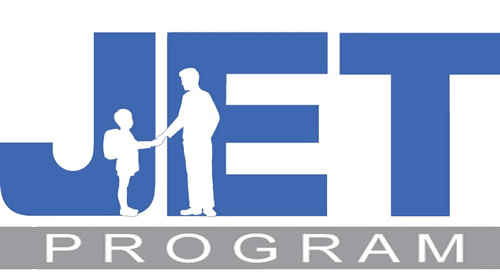
JET logo
The JET program or Japan Exchange and Teaching program is a teaching and exchange program which has been running since 1987.
It allows foreign teachers to come and work in Japan as TEFL teachers. It grew quickly and in 2002 at its peak over 6,000 teachers came to Japan through JET. In 2010 it brought almost 4,500 teachers to Japan. Over 50,000 teachers have passed through the JET system.
Many of these taught English (but also other languages and sports, etc) as ALTs (or Assistant Language Teachers).
In the first year teachers from the USA, United Kingdom, Australia and New Zealand came to Japan to work. Since then other nations have participated include Canada and Ireland and there are now participants of around 40 countries each year. By far the most teachers come from the US and there are currently some 2,300 US ALTs in Japan; the next highest numbers are about 500 from Canada and then 400 from the UK.
The program is run the by Japanese government and is an official government program. Each year we usually have several ICAL teachers apply for the program and the successful ones have all reported good things from their time spent in Japan living and working.
Application Procedure
If you are interested in getting into the JET program as a TEFL teacher you first need to contact your local Japanese Embassy. The program usually begins in late July or early August.
After the initial application is reviewed, successful applicants are called for an interview at the embassy or consulate. If successful, the candidate will be assigned a place and called to the embassy or consulate once again to attend a pre-departure briefing and Q&A.
And then you go!
Note, however, that it’s not usually possible to choose your location within Japan.
Successful applicants will show an interest in Japan and learning more about the culture and background. Many will speak some Japanese already and be actively studying the language and the program also provides language courses to extend this knowledge of Japanese.
As far as qualifications go, a degree is required (or sometimes a higher teaching qualification) and a teaching qualification is also needed. A number of ICAL teachers have successfully applied to JET and been accepted with their ICAL TEFL Certificate.
Warning
Application is free; some unscrupulous agents try to charge teachers for making an application on their behalf. You should avoid these!
In other words, go only through the official channels to apply for JET.
Conditions
Appointments are usually for 1 year; sometimes this can be extended if both parties agree to a maximum of 5 years.
Participants are given 300,000 JPY per month or [currconvert base_curr=”USD” base_amount=”3842″] after taxes with the airfare reimbursed at the end of the contract. The usual health insurances are included also.
The usual working week is 35 hours with (usually) the weekends free.
ALTs or Assitant Language Teachers are the most common positions in the scheme. Generally speaking ALTs help a Japanese teacher in the class, help prepare material and lesson plans and suchlike. They are also expected to be involved in the more cultural side of language teaching and participate in extra-curricular activities.
Useful Links
Official Website – JET Program
Teaching English in Japan – a guide to finding work and teaching in Japan



0 Comments